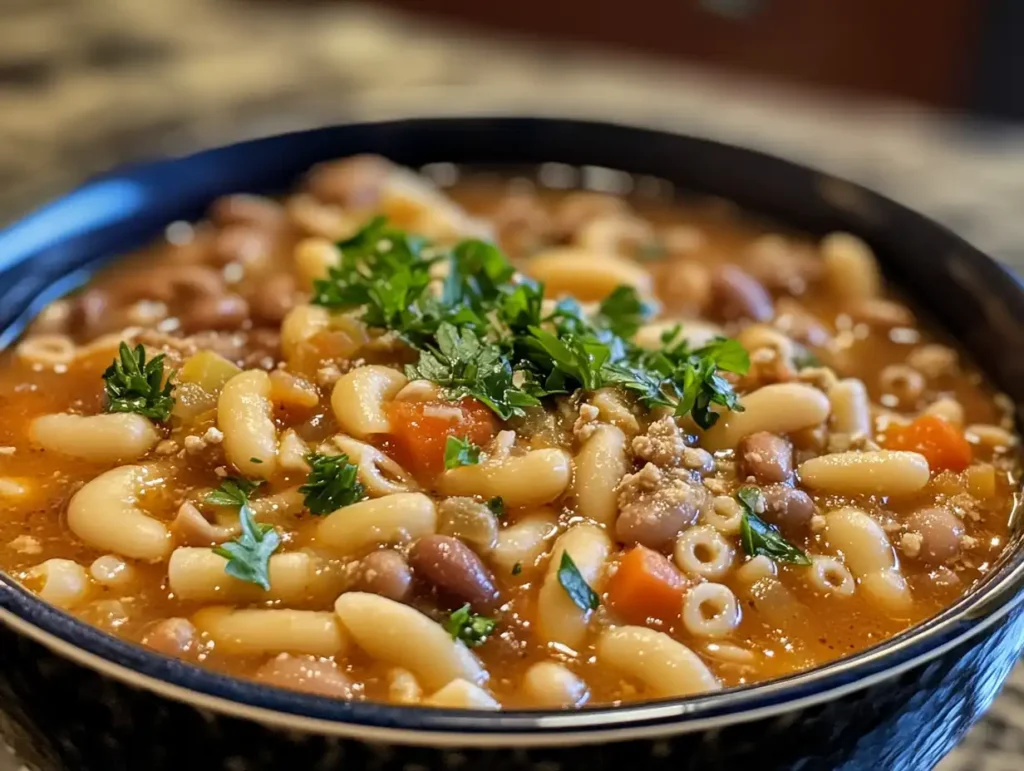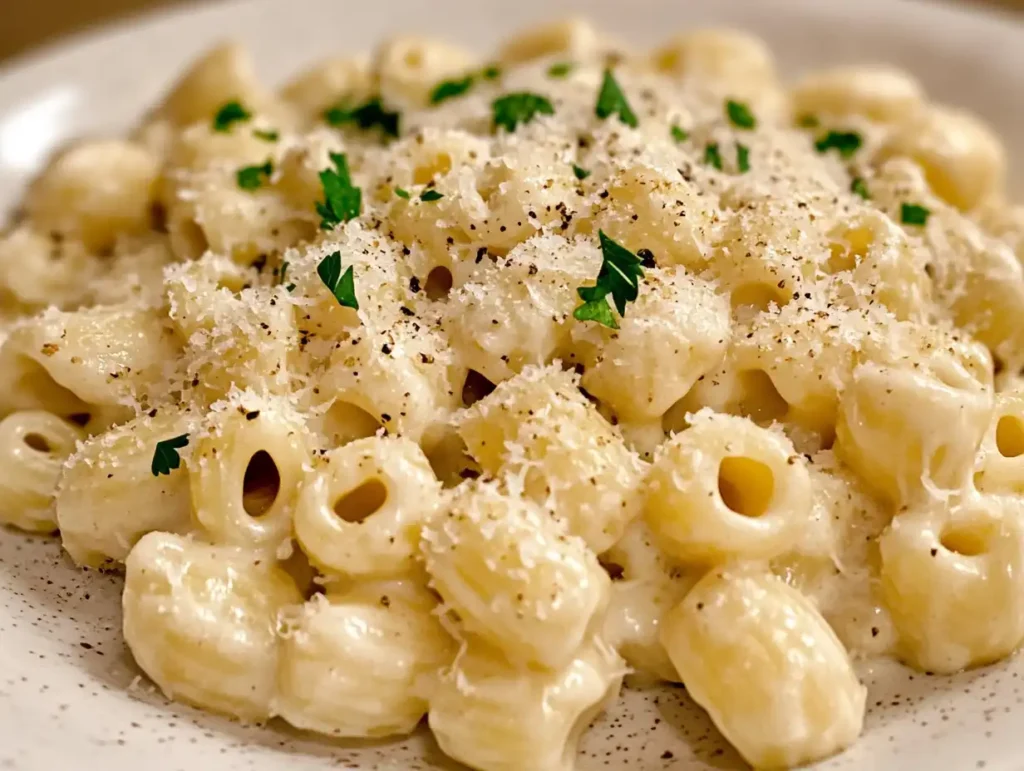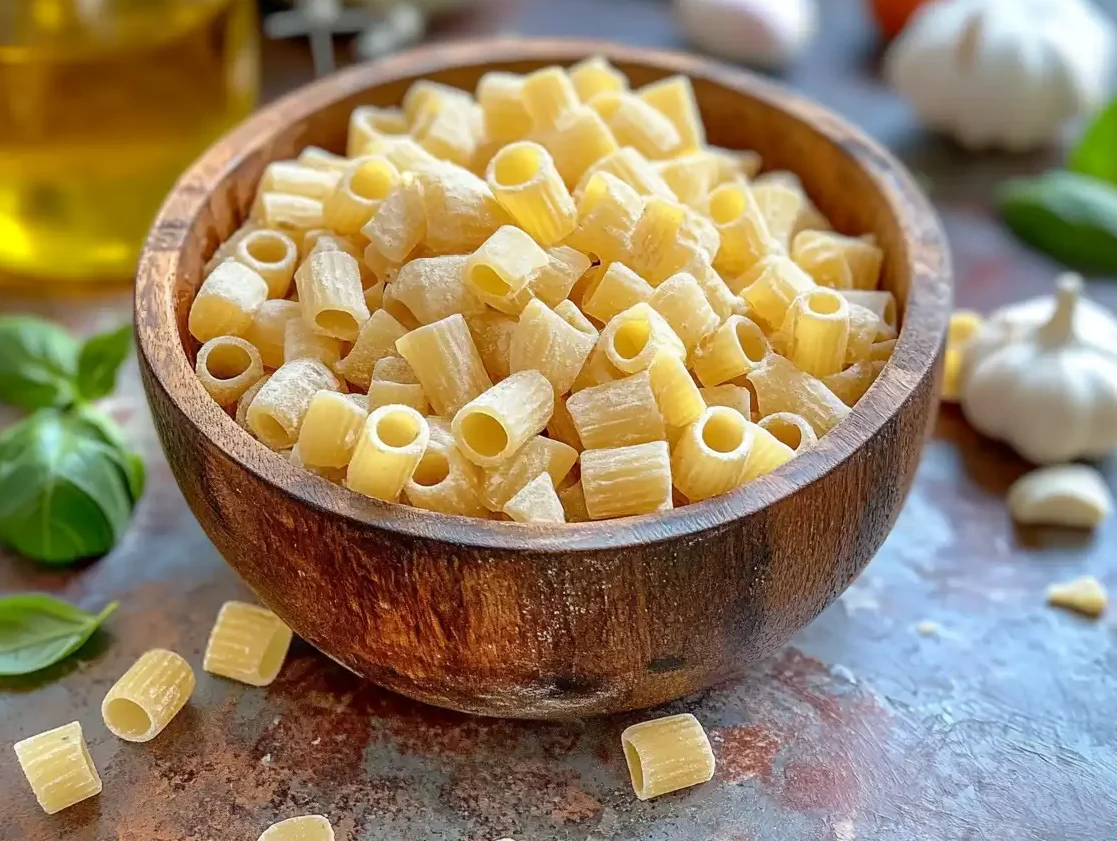Table of contents
Introduction
Ditalini, affectionately known as “little thimbles” in Italian, is a small, tubular pasta shape widely loved for its versatility and ease of use in various dishes. With its origins deeply rooted in Italian culinary traditions, this pasta is a staple ingredient in soups, salads, and hearty casseroles. Its compact size and ridged surface make it an excellent choice for trapping flavors, sauces, and broths.
Over the years, ditalini has gained popularity worldwide due to its adaptability to both traditional and modern recipes. Whether you’re preparing a comforting bowl of pasta e fagioli or experimenting with pasta salads, ditalini offers a reliable and delightful option.
This article dives deep into the world of ditalini pasta, exploring its history, characteristics, uses, and everything else you need to know to appreciate this charming pasta shape fully.
History of Ditalini Pasta
Origins of Ditalini
Ditalini pasta traces its roots to southern Italy, specifically regions like Sicily and Campania, where pasta culture thrives. Its name, which translates to “little thimbles,” reflects its tubular shape and diminutive size. Historically, ditalini was a common choice in rural households, prized for its ability to stretch ingredients in soups and stews, making meals hearty yet economical.
In traditional Italian cooking, ditalini was closely associated with cucina povera, a cooking philosophy emphasizing simple, affordable, and wholesome ingredients. Over time, its practical shape and ability to absorb flavors made it a favorite among Italian families and chefs alike.
Evolution Over Time
As Italian immigrants brought their culinary traditions to other parts of the world, ditalini became popular in American and European kitchens. Today, it is a staple in many households, particularly in recipes that celebrate Italian-American cuisine. Modern adaptations of ditalini recipes often feature creative twists, combining global flavors with this humble pasta.
Characteristics of Ditalini
Shape and Size
Ditalini pasta is small and tubular, usually about a quarter of an inch long. Its compact size makes it perfect for soups and stews, as it cooks quickly and blends seamlessly with other ingredients. The shape can vary slightly between brands, with some offering smooth tubes and others featuring ridges for added texture.
Texture and Cooking Versatility
The texture of ditalini is typically firm when cooked al dente, allowing it to hold up well in brothy or creamy dishes. Its small size also ensures even cooking, making it easy to incorporate into recipes where larger pasta shapes might overwhelm other ingredients.
Common Variations
While traditional ditalini is made from durum wheat semolina, gluten-free versions crafted from rice, quinoa, or corn are now widely available to cater to dietary preferences. Some brands also offer whole wheat or organic ditalini for health-conscious consumers.
Uses of Ditalini Pasta

Traditional Dishes Featuring Ditalini
Ditalini pasta is a key ingredient in several classic Italian recipes. Its small size makes it a popular choice for soups like pasta e fagioli (pasta and beans) and minestrone, where the pasta blends harmoniously with vegetables and legumes. Its ability to hold sauces and absorb flavors makes it indispensable in these hearty dishes.
Another traditional use of ditalini is in pasta salads, where its size allows it to pair well with ingredients like olives, tomatoes, and cubes of cheese. For more rustic preparations, ditalini can be found baked into casseroles with rich tomato or cream-based sauces.
Modern and Innovative Recipes
Beyond traditional recipes, ditalini has found its way into contemporary cooking. Some chefs use it in cold pasta salads with a tangy vinaigrette, while others incorporate it into fusion dishes like spicy ditalini stir-fries or ditalini mac and cheese. It also serves as an excellent base for creamy, cheesy one-pot meals.
Versatility in Cooking
Ditalini’s versatility goes beyond its ability to adapt to recipes. Its small, uniform shape ensures even cooking, making it ideal for dishes where texture matters. It works equally well in light, broth-based dishes as it does in rich, heavy sauces. This adaptability has made it a pantry staple for home cooks and professional chefs alike.
Ditalini and Italian Cuisine
Regional Italian Dishes with Ditalini
In Italy, ditalini plays a prominent role in regional cooking. For example:
- Campania: Often features ditalini in seafood-based soups.
- Sicily: Combines ditalini with lentils and herbs for a hearty vegetarian dish.
- Tuscany: Uses ditalini in traditional minestrone with fresh seasonal vegetables.
Each region offers a unique take on ditalini, showcasing its ability to complement a variety of local ingredients.
Pairing Ditalini with Sauces and Ingredients
Ditalini’s small size makes it ideal for pairing with both chunky and smooth sauces. It holds up well in creamy Alfredo-style dishes and absorbs the robust flavors of tomato-based sauces. Broth-based soups particularly benefit from its texture, as it does not overpower other elements in the dish.
Celebrating Italian Culinary Traditions
Using ditalini in recipes is a nod to Italy’s culinary heritage, where pasta is more than just a food—it’s a cultural icon. Incorporating ditalini into meals connects modern kitchens with centuries of Italian tradition, making it a delightful way to celebrate authentic Italian flavors.
Health Benefits and Nutritional Value
Nutritional Breakdown
Ditalini pasta, like other pasta varieties made from durum wheat semolina, is a good source of carbohydrates, providing energy for the body. A typical serving (around 2 ounces or 56 grams of dry pasta) contains:
- Calories: Approximately 200
- Protein: About 7 grams
- Fiber: 2-3 grams (higher in whole wheat versions)
- Iron: Around 10% of the recommended daily intake
Enriched varieties may also include essential nutrients like B vitamins and folic acid, contributing to a balanced diet. Gluten-free options offer similar nutritional benefits without the gluten, catering to those with dietary restrictions.
Health Benefits of Including Ditalini
- Energy Source: Ditalini’s carbohydrates provide sustained energy, making it ideal for active individuals.
- Heart Health: Whole wheat ditalini is a great option for those looking to increase their fiber intake, which can support heart health and improve digestion.
- Versatile and Balanced: Pairing ditalini with vegetables, lean proteins, and healthy fats creates a balanced meal that satisfies both taste and nutritional needs.
Gluten-Free and Whole Wheat Options
For those avoiding gluten, gluten-free ditalini offers a comparable taste and texture. Whole wheat ditalini is another excellent option, providing additional fiber and nutrients compared to traditional refined pasta. These alternatives cater to diverse dietary preferences while retaining the versatility and appeal of ditalini.
How to Cook Ditalini Pasta
Step-by-Step Guide to Perfectly Cooked Ditalini
- Boil Water: Use a large pot with plenty of water—about 4-6 quarts per pound of pasta. Add a generous pinch of salt to enhance the pasta’s flavor.
- Add Ditalini: Once the water reaches a rolling boil, add the ditalini. Stir occasionally to prevent clumping.
- Check the Cooking Time: Ditalini typically takes 7-10 minutes to cook. For soups, cook slightly less (about 6-8 minutes) to maintain firmness during simmering.
- Drain and Rinse (Optional): Drain the pasta in a colander. For cold dishes like salads, rinse under cold water to halt cooking and cool the pasta.
Tips for Perfect Results
- Avoid Overcooking: Overcooked ditalini becomes mushy, losing its texture and ability to hold sauces.
- Save Pasta Water: Reserve a cup of the starchy pasta water before draining—it can be used to thicken sauces or enhance the dish’s flavor.
- Flavor Boost: Toss hot ditalini with olive oil or butter immediately after draining to prevent sticking and add a subtle flavor boost.
Common Mistakes to Avoid
- Not Using Enough Water: Crowding the pasta can lead to uneven cooking.
- Skipping the Salt: Proper seasoning enhances the pasta’s natural flavor.
- Cooking Too Early: Timing is crucial; cook ditalini just before serving to ensure optimal texture.
Best Sauces for Ditalini

Broth-Based Sauces
Ditalini shines in soups and broths due to its small size and ability to absorb flavors. It pairs wonderfully with light broths made from chicken, beef, or vegetables. Popular examples include:
- Pasta e Fagioli: A classic Italian soup with beans, vegetables, and a light broth.
- Chicken Noodle Soup: A modern twist replaces traditional noodles with ditalini for a heartier texture.
Tomato-Based Sauces
The slightly ridged texture of ditalini holds tomato-based sauces exceptionally well. This makes it ideal for dishes like:
- Marinara Ditalini: A simple dish featuring ditalini tossed in a rich marinara sauce, garnished with fresh basil.
- Bolognese: While traditionally served with spaghetti or tagliatelle, ditalini offers a fun variation, especially in baked pasta dishes.
Creamy and Cheese-Based Sauces
Ditalini’s compact shape is perfect for rich, creamy sauces. It’s often used in dishes like:
- Ditalini Mac and Cheese: A sophisticated take on a classic comfort food, with a smooth cheese sauce coating each tiny tube.
- Creamy Mushroom Sauce: Ditalini complements earthy mushrooms and a velvety cream sauce beautifully.
Oil-Based Sauces and Dressings
For lighter meals, ditalini pairs well with olive oil-based sauces or vinaigrettes. These options are particularly suited for cold pasta salads or minimalist dishes. Examples include:
- Garlic and Olive Oil: A simple yet flavorful dish where the pasta’s subtle texture shines.
- Lemon Herb Salad: A refreshing cold salad featuring ditalini, olive oil, lemon juice, and fresh herbs.
Ditalini vs. Other Pasta Shapes
Ditalini vs. Macaroni
Both ditalini and macaroni are small, tubular pastas, but their differences lie in size and application. Macaroni is larger and curved, making it ideal for baked dishes like macaroni and cheese. Ditalini’s smaller size is better suited for soups and cold salads, where uniformity is key.
Ditalini vs. Orzo
Orzo, shaped like rice, differs from ditalini in both appearance and texture. While ditalini works well in soups, orzo is more common in pilafs and grain-like side dishes. Both are versatile but used in distinct culinary contexts.
Ditalini vs. Orecchiette
Orecchiette, meaning “little ears,” is a rounded, cup-shaped pasta that holds thick sauces well. Ditalini’s compact shape is more suited to brothy or lighter dishes, while orecchiette excels in robust recipes.
Advantages of Choosing Ditalini
- Size Versatility: Works seamlessly in soups, stews, and salads.
- Cooking Speed: Its small size ensures quick cooking times, making it a convenient option.
- Flavor Absorption: The tubular shape captures sauces, broths, and dressings, enhancing the dish’s overall taste.
Popular Brands of Ditalini
High-Quality Brands to Try
- Barilla: One of the most widely recognized pasta brands, offering consistent quality and taste.
- De Cecco: Known for its traditional pasta-making methods, De Cecco produces ditalini with excellent texture and flavor.
- Colavita: Offers a range of authentic Italian pastas, including ditalini, often made with 100% durum wheat semolina.
- Rummo: A favorite for its slow-dried, artisanal pasta, delivering a superior al dente texture.
When shopping for ditalini pasta, quality matters. Some popular brands known for their exceptional ditalini include:
These brands are readily available in most grocery stores or online, ensuring you can enjoy ditalini at its best.
How to Store Ditalini Pasta
Storing Dry Ditalini
- In Original Packaging: Unopened packages of dry ditalini can be stored in a cool, dry place, away from direct sunlight.
- In Airtight Containers: Once opened, transfer ditalini to an airtight container to maintain freshness and prevent exposure to moisture or pests.
Storing Cooked Ditalini
- Refrigeration: Store cooked ditalini in an airtight container in the refrigerator for up to 3-5 days. Toss with a bit of olive oil to prevent sticking.
- Freezing: Cooked ditalini can be frozen for up to three months. Freeze in small portions to reheat conveniently for soups or casseroles.
FAQs About Ditalini Pasta
Can Ditalini Be Used in Gluten-Free Recipes?
Yes, gluten-free ditalini is widely available and works well in most recipes. Popular brands like Barilla and Jovial offer gluten-free versions that mimic the texture and taste of traditional pasta.
What Are the Best Alternatives to Ditalini?
If ditalini is unavailable, other small pasta shapes like macaroni, small shells, or orzo can be used as substitutes. These options share a similar size and cooking time, making them suitable for soups, salads, and casseroles.
How Do I Prevent Ditalini from Overcooking in Soups?
To avoid overcooking, add ditalini to soups during the last 8-10 minutes of cooking. Alternatively, cook it separately and add it just before serving to maintain its firmness.
Is Whole Wheat Ditalini Healthier?
Whole wheat ditalini contains more fiber and nutrients compared to refined pasta, making it a healthier choice. It’s particularly beneficial for those aiming to improve digestion or follow a balanced diet.
Can Ditalini Be Used for Desserts?
While less common, ditalini can be adapted for dessert recipes like sweet pasta puddings or casseroles, using ingredients like milk, sugar, and spices.
Enhance Your Knowledge with Related Pasta Insights
- Learn how Ditalini Pasta: A Culinary Delight and Versatile Ingredient can enhance a variety of dishes with its adaptability and unique shape.
- Discover What Is the Closest Pasta to Ditalini? for creative substitutions in recipes requiring Ditalini.
- Explore the rich flavors of Mushroom Spinach Pasta: A Nutritious and Delicious Recipe for another hearty pasta dish idea.
Conclusion
By now, you’ve gained a complete understanding of what kind of pasta is ditalini. Its small, tubular shape and adaptability make it a favorite for soups, salads, and casseroles. Whether paired with a hearty tomato sauce or included in a light broth, ditalini’s versatility knows no bounds.
From its rich history to modern applications, discovering what kind of pasta is ditalini opens up endless culinary possibilities. Add it to your next dish and experience the charm of this iconic pasta firsthand!
